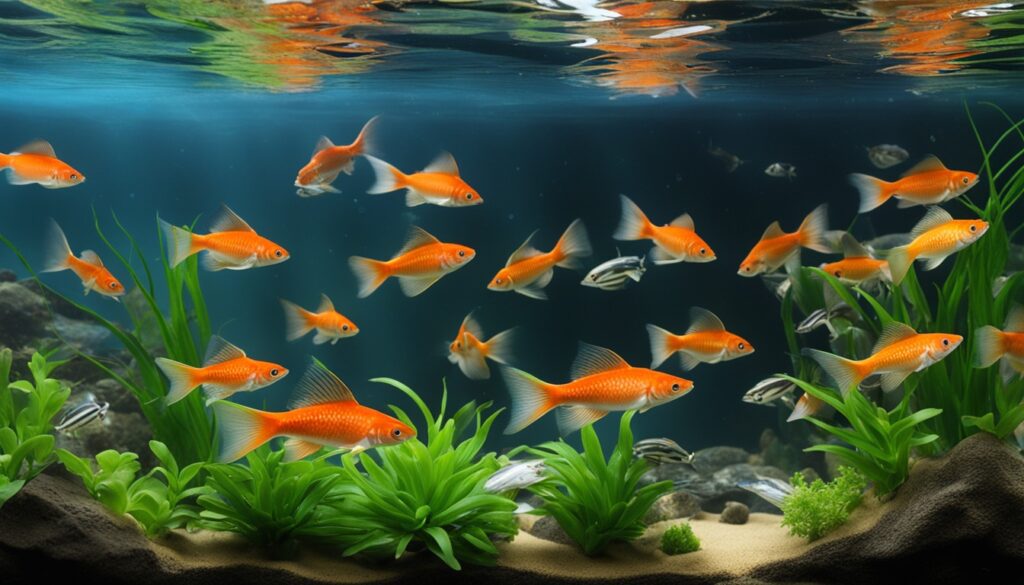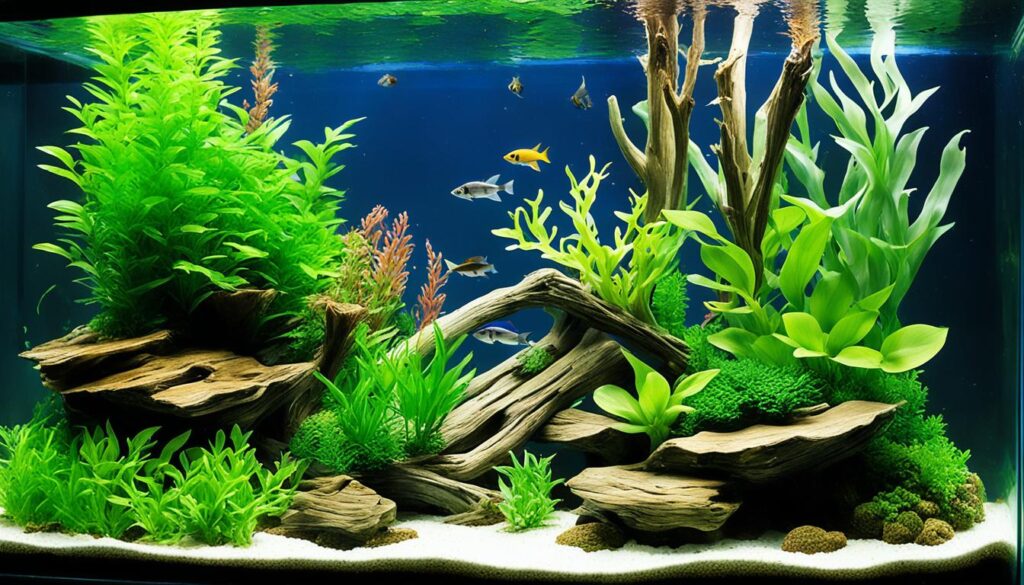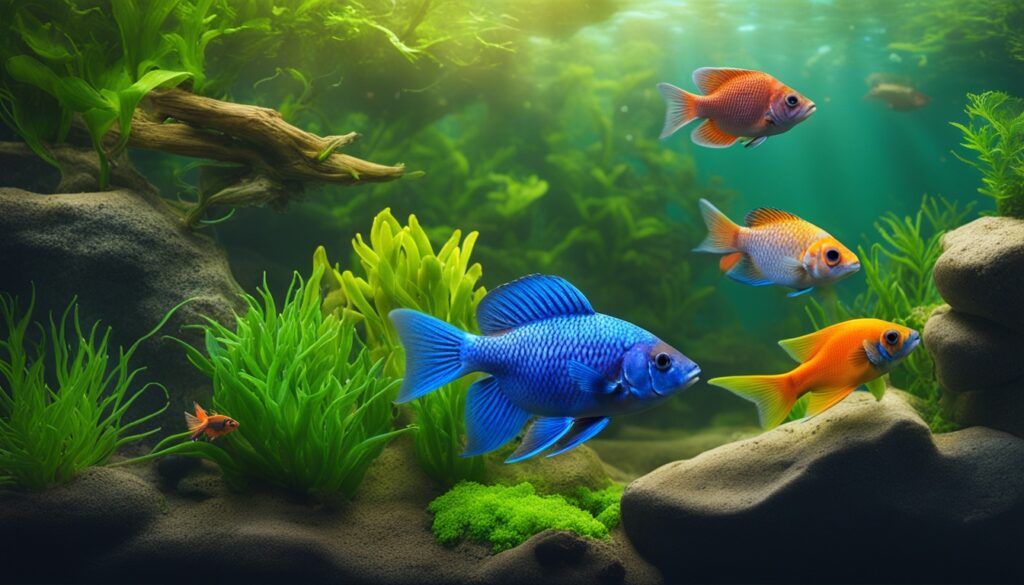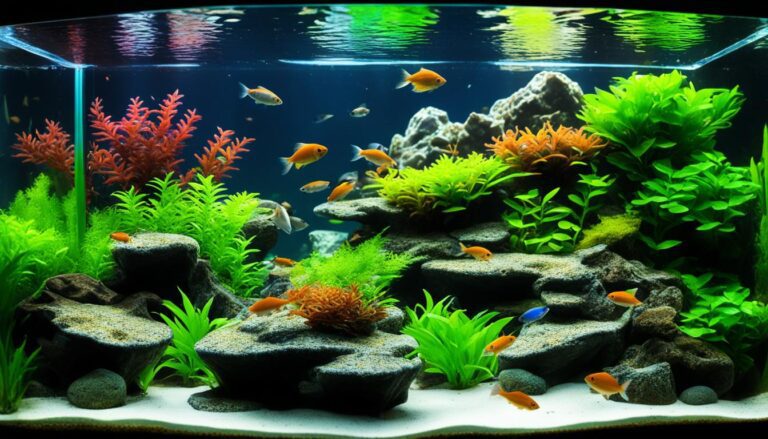I love creating peaceful underwater worlds in my home. Today, I’m excited to share tips on caring for the hastatus cory, also as known as Corydoras Hastatus. This tropical fish is a joy to watch and a great addition to any aquarium. Let’s explore the basics of aquarium care and fish tank setup for these unique fish.
Knowing how to care for hastatus corys is crucial if you’re thinking of getting one. These fish come from the Amazon and Paraguay River Basins. They bring a touch of the exotic to our homes. For those looking to set up a nano or planted aquarium, these fish are perfect. They love to swim together, creating a lively scene in your tank.
Corydoras Hastatus Species Profile

Welcome to the world of the Hastatus Cory, a small but vibrant fish that can brighten your aquarium. Known as Corydoras hastatus, this fish is loved for its shiny body and unique black spot at the tail. As an aquarist, I find their needs and behaviors fascinating, making them a great choice for learning about marine life.
Hastatus cory identification is key for fish lovers wanting a beautiful tank. These fish come from the rich waters of Argentina, Bolivia, and Brazil. They thrive in captivity if their needs are met. This guide will help you create a perfect home for your Hastatus Cory.
Creating the right aquarium setup is vital. They prefer quiet, shallow waters with lots of places to hide. Using clay or muddy substrates helps them feel at home. A well-thought-out aquarium layout supports your Hastatus Cory’s health and brings nature indoors.
For them to thrive, focus on the right conditions: 68 – 82°F water temperature, pH 6.0 – 8.0, and 5 – 20 dGH hardness. Feeding them high-quality foods like bloodworms and daphnia keeps them healthy and lively.
Let’s look at a detailed table for the best conditions and traits for Hastatus Cory:
Characteristic |
Detail |
|---|---|
Maximum Size |
3.5 cm |
Lifespan |
Up to 5 years |
Ideal Temperature Range |
68 – 82°F (20 – 27°C) |
pH Range |
6.0 – 8.0 |
Water Hardness (GH) |
5 – 20 |
Dietary Preference |
Omnivore |
Spawning Frequency |
Eggs laid every three minutes over several hours |
Typical Habitat |
Inland water habitats such as channels, lakes, and swamps |
Using these tips in your aquarium care will help create a thriving marine world. Let’s enjoy the journey of caring for these beautiful fish, making our hobby even more rewarding.
Features of Corydoras Hastatus

This particular fish is known for its unique look and lively behavior in freshwater fish tanks. It’s a small species that catches the eye with its appearance and how it interacts in the aquarium. Let’s explore what makes the Corydoras Hastatus special, from its looks to how it fits into aquarium care.
Identification and Physical Description
This type of Corydoras stands out with its mix of sizes and colors. They have a white to olive body, a dark stripe from the gill cover to the tail, and a black spot at the tail’s base. Adults grow to about 3.5 cm, ideal for smaller tanks. Their colors and lively swimming make them a highlight in any aquarium.
Lifespan and Growth Patterns
Corydoras Hastatus can live up to 5 years with the right care, showing their toughness and flexibility. Females are usually bigger than males, with a wider body when seen from above. This difference is interesting for those who want to breed these catfish.
Behavioral Traits Unique to Hastatus Cory
In aquariums, Corydoras Hastatus behave uniquely compared to other Corydoras species. They like swimming in the middle of the tank, among plants and dense vegetation. This makes their tank more lively, as they’re not just bottom feeders but active swimmers. They also like to be with others, making them great for community tanks.
Ideal Aquarium Setup

Creating the perfect aquarium setup for Hastatus Cory means knowing and applying a few key ideas. They need a space that closely matches their natural home. Tropical fish like Hastatus Cory do well in a tank that offers swimming room, clean water, and the right group size.
Appropriate Tank Size and Group Numbers
Choosing the right fish tank setup begins with the right aquarium size. Hastatus Corys are lively and like to be with others. They need at least 10 gallons, but 15 gallons is better for a group of six. This size helps them act naturally, which is good for their health and color.
Plants and Hardscape
Adding plants and rocks to your tank is key. Hastatus Corys like places to hide and feel safe. Driftwood, rocks, and strong plants make the tank feel like their home in the river. This helps reduce stress and fights with other fish.
Water Requirements: pH, Hardness, and Temperature
Keeping the water right is crucial for Hastatus Corys. They can handle a range of water conditions, but it should be between pH 6.0 to 8.0 and 5 to 20 dGH hard. The temperature should be 68 to 82°F to match their tropical home. Regular aquarium maintenance like checking water and changing it is a must to keep the tank healthy.
By using these tips on aquarium setup, tank size, and water, you can make a great home for your Hastatus Cory. They will stay healthy and active for many years.
Nutritional Needs and Feeding Tips

Feeding your hastatus cory the right foods is crucial for their health and happiness. These tropical fish have unique needs that you must meet. It’s important to know the best foods and how often to feed them for a healthy aquarium.
Optimal Foods for Health and Longevity
Hastatus corydoras eat a variety of foods that match what they find in nature. High-quality dried foods like granules, flakes, and catfish pellets are their main food. But, adding live, frozen, or freeze-dried foods like daphnia, bloodworms, and brine shrimp is also key. These foods give them the nutrients they need and help them act like they would in the wild.
Feeding Schedule and Quantity
Feeding your hastatus cory regularly but not too much is important. They should eat twice a day, and give them only what they can finish in a few minutes. The amount you give should depend on how many fish you have and their size. Watching how they act when you feed them can tell you if they’re healthy or need changes in their diet.
Remember, feeding them too much can harm the water and the fish. Baby hastatus cory need to eat often, with foods like micro worms and finely crushed flakes. This helps them grow strong and healthy.
Food Type |
Description |
Frequency |
|---|---|---|
Dried Foods (Flakes, Pellets) |
Staple diet, easy to dispense and store |
Daily |
Frozen Foods (Brine Shrimp, Bloodworms) |
Rich in protein, aids in growth and health |
2-3 times per week |
Live Foods (Daphnia, Micro Worms) |
Enhances natural feeding behaviors |
Occasionally as available |
Following these feeding tips will help your hastatus cory stay healthy. Regularly maintaining your aquarium is also key for their well-being. This way, your tropical fish will thrive in their home.
Tank Mates & Companion Species

Choosing the right companion species for Hastatus Corys is key to a peaceful aquarium. These small, peaceful catfish do well with fish that are similar in size and temperament. They live best in water conditions that are just right for them.
When it comes to aquarium care, it’s important to know that Hastatus Corys are social fish. They like to be around others of their kind. So, keeping a group of 6-10 Hastatus Corys together is best to see them be happy and active.
- Neon Tetras: These fish are small and colorful, making them a good match for Hastatus Corys. They don’t compete with them for food or space.
- Chili Rasboras: These fish are peaceful and need the same water conditions as Hastatus Corys, making them great tank mates.
- Celestial Pearl Danios: This small fish is also peaceful and gets along well with Hastatus Corys.
- Otocinclus: These algae eaters are gentle and help keep the tank clean. They are perfect friends for Corys.
It’s important to keep bigger, aggressive fish away from Hastatus Corys. They are small and gentle. Here’s a table with some good friends for your community tank and what they like.
Species |
Size |
Temperament |
Ideal Water Conditions |
|---|---|---|---|
Up to 1.5 inches |
Peaceful |
pH 6.0-7.0 |
|
Up to 0.8 inches |
Peaceful |
pH 4.0-7.0 |
|
Up to 1 inch |
Peaceful |
pH 6.5-7.5 |
|
Otocinclus |
Up to 2 inches |
Peaceful |
pH 6.8-7.5 |
To take good care of your aquarium, check the water quality often. Keep the tank clean and feed each fish the right food. Doing these things helps Hastatus Corys and their friends stay healthy and happy in your aquarium.
Breeding Guide and Tips

Breeding hastatus cory in a home aquarium is rewarding for exotic fish fans. It involves setting up the right aquarium and caring for the fry. I’ll share how I do it to help these fish thrive.
The Breeding Environment
To breed hastatus cory, I create a special aquarium that mimics their South American home. It has aged water and lots of plants for hiding and laying eggs. A sponge filter keeps the water clean and protects the fry. I feed the fish a high-protein diet to get them ready to spawn.
Egg-Laying Patterns and Incubation
Female hastatus corys show clear signs when they’re ready to lay eggs. They lay 30-60 sticky eggs on the glass or plants. After spawning, I take out the adults to stop them from eating the eggs. Keeping the eggs free of fungus is key to successful incubation.
Hastatus Fry Care
Once the eggs hatch, the hastatus cory fry start their growth. They first eat their yolk sacs, then need live food. I feed them vinegar eels or microworms. To help them grow, I change the water often and check its quality closely.
Care Aspect |
Details |
|---|---|
Optimal Temperature |
22-30°C |
Recommended Group Size |
15-20 Corydoras |
Incubation Period |
Few days until hatching |
Fry First Food |
Vinegar eels or microworms |
Aquarium Maintenance |
Weekly water changes of 20-30% |
With careful care and the right aquarium setup, hastatus cory fry grow into healthy adults. This makes breeding them very rewarding. By learning and following best practices, I keep my exotic fish thriving.
Keeping Your Hastatus Cory Thriving
Keeping your aquarium clean is crucial for your Hastatus Cory’s health and long life. These fish can live up to 4 years in a well-maintained tank. A consistent cleaning routine is essential for their well-being.
Every week, I check the water conditions for my Corydoras. I make sure the pH level, temperature, and hardness are just right. Changing 20-25% of the water weekly helps keep nitrates low and mimics their natural habitat.
It’s important to protect their environment to prevent stress and health problems. I ensure my 10-gallon tank is big enough for them to swim and for proper filtration. This also means using a substrate that doesn’t compact and create harmful gas pockets.
Looking after an aquarium is a daily task. Watching for any changes in your fish can help spot health issues early. Taking care of my Hastatus Cory is more than a hobby; it’s a promise to give them a happy, long life in their aquatic home.







